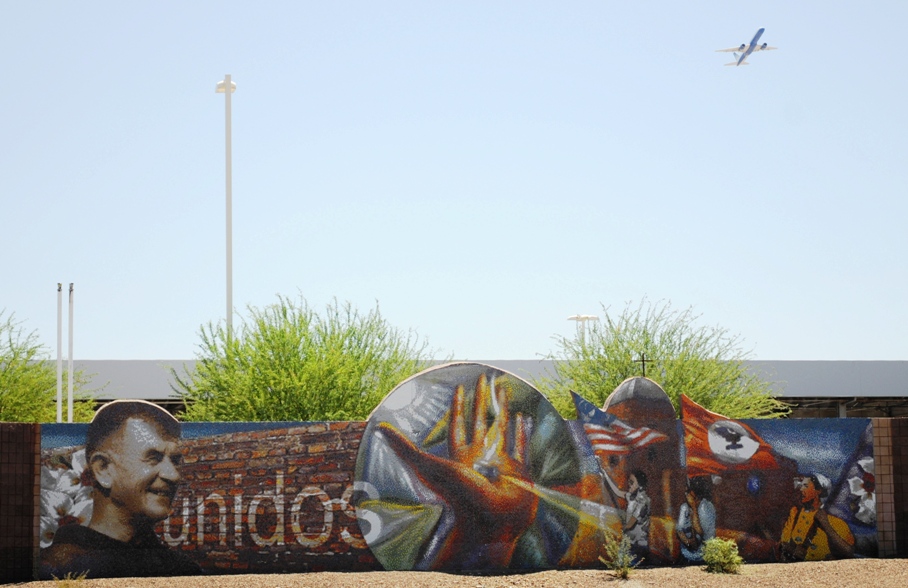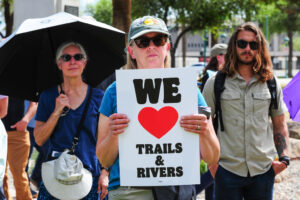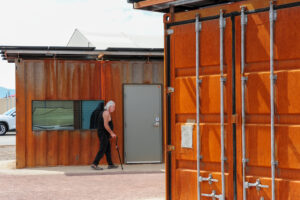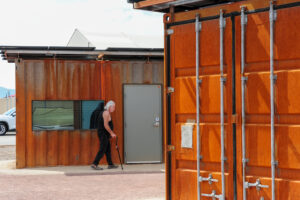(Phoenix, Arizona) — Once the Arizona Territory was created, military troops were brought in to stabilize the hostile Indians, and to protect miners from Indian attacks. Fort McDowell, on the Verde River, was established in 1865 for this reason. The establishment of Fort McDowell led to the arrival of many Mexicanos drawn northward from Sonora, who sought opportunities for employment at Fort McDowell and along the Salt River with John Y.T. Smith. Smith possessed a legal contract to supply Camp McDowell with fodder in order to supply the needs of cavalry, draft animals, and other livestock at the fort. He established his hay camp along the Salt River, near south Phoenix, and on the eastern edge of what is now known as the Sky Harbor International Airport. Smith hired the Mexicans who camped along the southern portion of the Salt River to cut the hay, and he constructed makeshift shelters for them along the natural flow of the river. These Mexicans served Smith and Camp McDowell as post guides, as translators, laborers, or as interpreters for the military forces. For example, Paz Salazar served as post guide for Captain James Curtis, Troop 1, 3rd Cavalry, on missions to make contacts with the roaming Apaches in September 1871. And post guide Pedro Lachesuo was hired to help the Mexican civilians, who were hired as adobe makers for the repair of run-down buildings. These Mexican adobe artisans also built new structures for the garrison of Camp McDowell in early 1872.
Related → A Vanished Phoenix Barrio: Visions of Life on 16th Street
John W. “Jack” Swilling’s 1867 arrival to the Salt River Valley has to be acknowledged here. The mention of his name, however, creates conflicting and somewhat mythical accounts of his moral character and of his activities in early Phoenix. Anglo settlers who homesteaded in the Salt River Valley during the early 1870s were Confederate soldiers and veterans from the deep South. It was common knowledge among them that Jack Swilling had deserted the Confederate Army in New Mexico. His role in the Civil War was viewed as a negative one, as rumor had it that he was also a wanted man in Texas, and that he became a civilian scout for the Union forces. Nevertheless, Swilling’s role in the development of early Phoenix remains important, as are his ties to the Mexicanos, with whom he forged friendships through his Mexican born wife, Trinidad Escalante Swilling. As irrigation workers, Mexican laborers helped Swilling develop the Old Town Ditch, or the “Swilling Ditch”, along Van Buren Street in the south Phoenix townsite in 1867 by following the network of canals built by the Hohokam Indians from A.D. 300 to 1400. Frontiersman Swilling and his Catholic wife, Trinidad, were already living near south Phoenix in an adobe house not far from 36th Street and Washington. Their home was “the site of the first Mass celebrated in Phoenix” by Father Andre Eschallier and was also recognized “as the first permanent American dwelling erected in the Salt River Valley by a White settler,” meaning Swilling. Some Phoenix historians recognize Jack Swilling as the “father” of Phoenix. If this is so, then Trinidad Escalante Swilling can be considered the “mother” of Phoenix, which suggests that Phoenix may have also been founded by a Mexican woman.
By 1870, at least 240 residents lived in the Phoenix townsite, and 124 of them were Mexicans. They became the zanjeros who constructed acequias, or canals, along the Salt River. The construction of these canals made a controlled and dependable water supply of water available to valley farmers. This water distribution system constructed by the Mexicans was the early beginning of today’s Salt River Project. Mexican workers also helped in the first survey directed by William A. Hancock in 1870 and leveled and maintained the public streets of Phoenix. By 1877, the Phoenix population comprised 500 people, one- half of whom were Mexicans. At that time, the county of Maricopa was created by legislative enactment and Phoenix was declared its county seat. Subsequently, Phoenix became an incorporated city in February, 1881 and John T. Alsap was elected its first mayor. It is clear that the Mexican presence was firmly established in Phoenix by then. It is known that Mexican families sent their children to the first public school classroom in September 1871. This classroom was held in the courtroom of the County Building on south First Avenue, at that time known as Cortez Street. Among the pupils attending school were Angel Moreno, Francisco Rodriguez, and Jose Rodriguez.
In the years 1886 and 1887, Mexicans graded the roadbed and laid the tracks for the Maricopa and Phoenix Railroad, connecting the city of Phoenix with the Southern Pacific mainline at Maricopa. They also laid the tracks for the mule-drawn streetcars of the Phoenix Street Railway Company, which brought public transportation to Phoenix in 1887. In his research on the early history of Phoenix, Geoffrey P. Mawn suggests that Phoenix had the appearance of a Mexican settlement in the late 1870s and early 1880s. Mexicans made the sun-dried adobe bricks used in business and residential structures in south and central Phoenix. Adobe buildings dotted Washington Street, the main business thoroughfare of Phoenix, including Clemente Romo’s store and Jesus L. Otero’s buildings. Thick adobe walls were ideally suited to the needs of keeping rooms cool during the scorching summers and warm in the winter.
Occasional heavy flooding and a proximity to unsightly railroad tracks south of the Salt River made the area undesirable for living and economic development by more arrivals of Anglo speculators, carpetbaggers, and entrepreneurs to the Phoenix townsite. The 1891 flood that overflowed the southern Salt and reached Washington Street further discouraged more settlement of Anglos in the south Phoenix area. As a result, they moved into the north side of the Salt River, leaving the Mexicans to remain south of Washington Street between Twenty-fourth Street and Twenty-Seventh Avenue.
South Phoenix’s pastoral and agricultural atmosphere attracted Mexican families who homesteaded and made their living in farming and ranching. For many, however, their dreams of land ownership were quashed in the 1890s by the enterprising and unscrupulous Michael Wormser, a Jewish merchant from Prescott. Between 1873 and 1896, Wormser acquired at least 9,000 acres between the Salt River and what became Central Avenue, 48th Street and Baseline Road. He also obtained the rights to the San Francisco Canal and convinced the Mexican farmers that he would provide their land with water. When the Mexicans encountered financial difficulties in maintaining their land and proving their homestead claims, Wormser began purchasing their lands. He hired the Mexicans to make much-needed repairs on the canal, and convinced them that he could safeguard their land at the same time. He provided them with seed grain and supplies on credit, and soon held liens on much of the Mexicans’ farm lands when they could not pay him what they owed. In the meantime, the Mexicans turned their underdeveloped tracts of land into prime agricultural acreage. They still held hopes that they would gain a financial return for their land and products and pay off their debts to Wormser. But Wormser knew differently. He knew that he could take away any claims the Mexicans held to their land because he had financial power over them. He cut off their water supply from the San Francisco Canal and forced them to sell him their land at his price.
South Phoenix began coming into its own in 1911, the year in which the Roosevelt Dam was completed. This meant the reduction of flooding along the Salt River. The irrigation from the dam provided the impetus for establishing Pima cotton farms. This endeavor brought more Mexican laborers into the cotton fields and the alfalfa fields nearby. In the early 1920s, Mexicans also herded cattle and maintained the feed lots for the Bartlett-Heard Land and Cattle Company, a rich 6,500-acre spread. Mexican women like Mauricia Vega performed housekeeping, cooking and laundry duties for Dwight Heard’s family and the families of other Anglo homesteaders. Other south Phoenix Mexican families picked oranges and dates from trees that grew in abundance on Heard’s ranch properties. Heard shipped the fruit by rail to East Coast markets. Ostrich farming was also a south Phoenix industry between 1900 and 1916 and Mexicans helped to raise and care for the birds on ranch sites on 36th Street and Broadway; 16th Street and Southern; and 19th Avenue and Broadway. Two classes of people dominated south Phoenix in the mid-1920s: the homesteaders, both Mexicans and Anglos; and the laborers, virtually all of them Mexican. As the South Phoenix community expanded and more families settled in the area, its infrastructure continued to grow. By 1911, the Center Street Bridge (later known as the first Central Avenue bridge) was completed. Roosevelt School opened that same year at Southern Avenue and Seventh Street on land donated by land baron, Dwight B. Heard. Wirt Standring opened a grocery store near Central and Broadway. Residents established the Neighborhood House near Central and Southern Avenue, which became the center of south Phoenix social activities for both the Mexicans and the Anglos, although the Anglos managed its direction. South Phoenix received electricity in 1924, after the Roosevelt Men’s Club raised almost $20,000 to bring it in.
By the 1930s, Mexican barrios formed into distinct sections, as identified in a 1972 study by graduate students Jon Aumann, Mary Hernandez, Manuel Medina, Cheryl Stewart and Nancy Wherley.
1) “Golden Gate,” or puerto de oro, bordered by 16th Street on the west, 20th street on the east, Sherman Street on the north, and Buckeye Road on the south;
2) “Las Milpas”, or “Cuatro Milpas” (“the Cornfields”, or “Four Cornfields” ) bordered by 12th street on the west, 14th street on the east, by Buckeye Road on the north, and Mohave Street on the south;
3) “El Campito”, (the “little camp”), bordered by 7th Street on the west, 12th Street on the east, by Tonto Street on the north, and by Buckeye Road on the south;
4) “Los Marcos de Niza” housing project, bordered by 4th Avenue on the west, Central Avenue on the east, the north end of Yavapai Street on the north and by Mohave Street on the south;
5) “Las Avenidas” (“the Avenues”), bordered by 1st Avenue on the west, by 7th Avenue on the east, by the old Grant and Lincoln highway on the north, and by the north end of Yavapai Street on the south;
6) “La Sonorita” (“Little Sonora”), bordered by 15th Avenue on the west, 7th avenue on the east, Pima Street on the north, and by Mohave Street on the south;
7) “La Diez and Nueve” (the Coffelt Housing Project) bordered by 22nd Avenue on the west, 19th Avenue on the east, Buckeye Road on the north and Mohave Street on the south;
8) The River-Bottom, bordered by 16th Street on the west, 19th Street on the east, Encinas Lane on the north, and by Wood Street on the south; and,
9) “La Vente ” (the Duppa Villa housing project), bordered by 16th Street on the west, 20th Street on the east, by McKinley Street on the north and by Villa Street on the South.
© 2006 - 2025, Dr. Christine Marin. All rights reserved.





